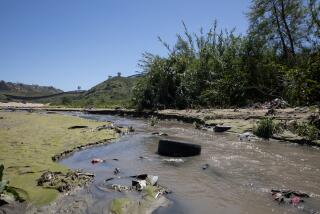Sewage Stench, Gas Force Families Out of Houses
Alan and Terry Morelli purchased a Pacific Palisades home three years ago, never suspecting that their dream of residential happiness would go down the drain.
But for two years, noxious odors have risen from the bowels of their toilet, sink and shower drains into their $800,000 home on Mantua Road, because of what city officials say is a glitch in a sewage improvement project.
The Morellis said they have been haunted by frequent bursts of eye-stinging gas and by groaning pipes.
“My wife comes into the bedroom at night almost in tears and says, ‘They’re back,’ ” Alan Morelli said of the day-on, day-off rumbling of pipes. “It’s almost like a poltergeist.”
Flu-like symptoms lasting up to six months, which they fear are related to hazardous methane and hydrogen sulfide gases or microorganisms, add to their horror.
The Morellis have been living at their second home in Benedict Canyon since December.
“I’m not bringing my 1-year-old back in that house until I’m sure it’s safe,” said Terry Morelli, coddling her infant son Giancarlo. And they are not alone.
Susan Kudo, another resident on Mantau, said, “I have not been able to live in my own home” because of similar problems. She is staying with friends in Oregon until the situation is resolved.
A third resident, Sheila Greger, said the odor from her two neighbors’ homes and a nearby manhole has made her so ill that she once had to be hospitalized.
What one city official called a nonhazardous “nuisance” stems from a $14-million sewer improvement project. Plans for the project called for installing a new main sewer line, known as a force main, along Pacific Coast Highway and rerouting some home sewage lines from a series of small pumping stations to the new main. The aim was to improve efficiency and reduce maintenance.
For the Morellis, it was the start of a series of problems.
They began when city-contracted workers in February 1998 excavated the eastern slope underneath the couple’s newly purchased home to lay a pipe that would feed into the new main.
Despite the onset of El Nino rains and protests from residents, the Morellis and Greger said, workers stripped the slope of vegetation and began digging. Mudslides ensued.
That spring, the city ordered the Morellis to repair the damage. The couple is fighting that order and says the city should pay for the damage.
Then came the rotten-egg stench burped up by their plumbing whenever a nearby pumping station kicked in--sometimes every 20 minutes, sometimes once every six hours, depending on the time of day.
For nearly two years, the couple said, they thought the problem was their 50-year-old sewer pipes, which they planned to replace when the house was remolded.
Last fall, the Morellis learned from Kudo that the problem was not theirs alone. The city was alerted.
In the months that followed, Department of Public Works staff determined that a portion of the new system allowed no place for hydrogen sulfide and other sewage gasses to escape.
“Because of the height of houses on the hill, someone decided that you could hook [the sewage lines] right to the force main,” said civil engineer Rory Shaw of the Bureau of Waste Management. “The problem with that is that they thought of a sewer as only containing water, but it also carries air.”
That air, Shaw said, is replaced by hydrogen sulfide--a potentially hazardous gas--as sewage decomposes.
In December, vents were installed on both properties to allow the gas to escape. The indoor odors lessened, the Morellis said, but didn’t stop.
The pressurized gas was then forced out of a nearby manhole in gusts that, Terry Morelli said, “would part your hair.”
In January, city workers responded to complaints by stopping up the manhole leak, sending the gases again full force back into the two homes.
“It was like a real Keystone Kops on the hill,” Terry Morelli said.
Alan Morelli sought help from Councilwoman Cindy Miscikowski, and in March city officials met with the two households pledging an immediate, temporary solution, followed by permanent repairs. They waited.
It took about two weeks for the city to get the needed right-of-way approval from CalTrans, Department of Public Works division manager Barry Berggren said. Then the families--deciding they had waited long enough--hired an attorney. Repairs began April 12 and continued this week.
The solution, Shaw said, is to reroute the two sewage lines back to the original pumping station.
City officials say federal work standards for exposure to hydrogen sulfide were not exceeded. Under the federal guidelines, exposure to up to 30 parts per million for a 40-hour workweek is safe, he said.
“There is no danger to the families,” Berggren said. “The hydrogen sulfide is barely at the detectable limit.”
Measurements of the manhole detected 6 ppb and less than 3 ppb in the Morellis’ home, Shaw said. But no measurements were taken when sewage pumps were forcing gas into the home, he conceded.
Attorney Barry Groveman, who was hired by the families, said the city has broken three laws regarding sewage discharges, pollution and failure to notify health authorities.
Michael Kaplan, an attorney for the city, argues: “They’re supposed to be notified only when the threatened discharge is likely to cause substantial injury to public health and safety,” he said.
Officials are confident that taking the Morellis’ sewage pipe off the pressurized main will do the job, but there’s no guarantee that the problems are over.
“Nobody else has complained,” said Shaw. “But it is quite possible that somebody else is subjected to the fumes. The pressure is still flowing.”
Times staff writer Soraya Sarhaddi Nelson contributed to this story.
More to Read
Sign up for Essential California
The most important California stories and recommendations in your inbox every morning.
You may occasionally receive promotional content from the Los Angeles Times.










